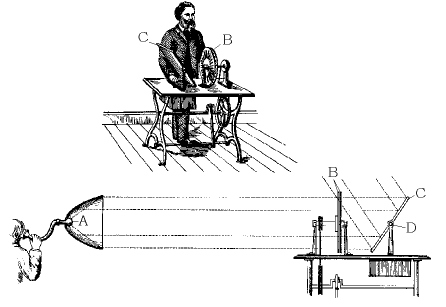Brief history
The photoacoustic effect was discovered by Alexander Graham Bell and led to the invention of a new communication device, the photophone (Figure 1). However, photophone's success was completely overshadowed by the other communication device also invented by Bell. With the assistance of Tainter, Bell was able to "devise a method of producing sounds by the action of an intermittent beam of light" and to conclude that the method "can be adapted to solids, liquids, and gases" [1]. Figure 1 (adapted from Bell's original publication), shows a photophone, "an apparatus for the production of sound by light", used by Bell to investigate the photoacoustic effect. The controversy around the origin of this phenomenon was settled by Bell himself and by Lord Rayleigh and their views were rather close to our present understanding: when a light pulse is absorbed by a substance, a given amount of heat is deposited, producing a local thermal expansion; this thermal expansion propagates through the medium, generating sound waves. The photophone had two similarly perforated disks (B), one stationary and the other subject to rapid rotation (note another good application of a sewing machine), which were used to produce the pulsed light beam. This beam was aimed at a parabolic reflector. A glass vessel containing "lampblack or other sensitive substance" was placed at the reflector's focus and connected to a hearing tube. "In operating the instrument, musical signals like the dots and dashes of the Morse alphabet are produced from the sensitive receiver (A) by slight motions of the mirror (C) about its axis (D)".

Figure 1
The scientific explanation of the phenomenon and the operation principles of the photophone were understood at the time (although a mathematical description was only possible in the middle of last century, by Landau and Lifschitz [2]), essentially agreeing with the current interpretation: when a substance absorbs a pulse of light, heat is generated, leading to a localized thermal expansion; this sudden expansion originates a pressure wave (an acoustic wave) that travels through the medium. A thorough discussion is given elsewhere, but first it is interesting to compare the photophone with the simplified photoacoustic calorimeter in the main page, noting the correspondence between the principal components: initiation system, cell, and photoacoustic detection system.
The first "useful" application of the photoacoustic effect was accomplished by Viengerov (ca. 1938) [3], quite some time after Bell's experiments. He studied the absorption of light in gaseous samples and obtained estimates of their concentration through the magnitude of the photoacoustic signals produced, pioneering the photoacoustic spectroscopy technique.
Later, in the 1980s, Tam and Patel [4,5] were responsible for a major development of the technique, when they managed to measure absorbance coefficients as low as 10-6 cm-1, which represented a detection limit 1000 times lower than what was attainable at the time, using conventional spectroscopy. They established not only the modern technological basis of the method, by using pulsed lasers as the light source and piezoelectric transducers as the photoacoustic detectors, but also provided the complete theoretical description of the photoacoustic phenomena, based on the original concepts of Landau and Lifschitz [2].
Finally, photoacoustic calorimetry (PAC) was adapted from the methods developed by Tam and Patel by the groups of Peters [6] and Braslavsky [7], around 1983. Since then the method has been extensively used (and further developed) by several groups with different aims [8]. The investigation of the energetics of transient species in solution is a major application area of photoacoustic calorimetry. The first PAC studies of O—H bond dissociation enthalpies in phenol compounds were made by Griller and co-workers [9,10]. The setup of our laboratory is a development of their instrument.
